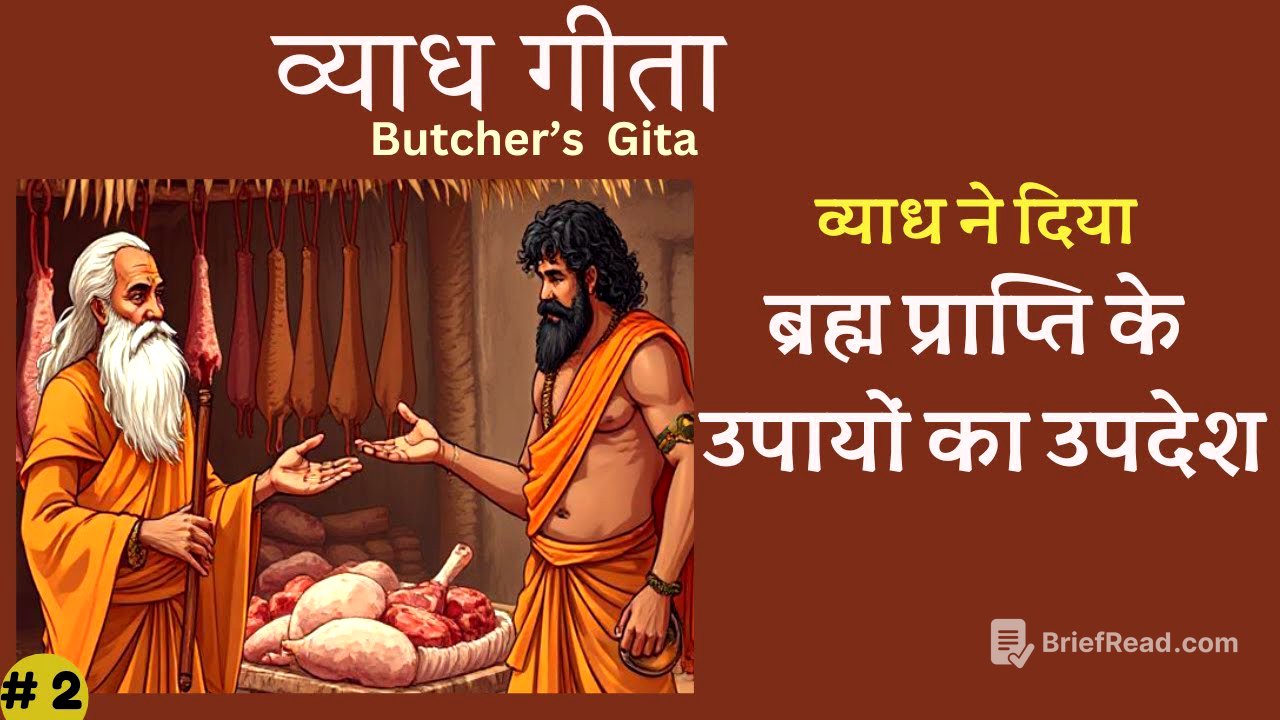TLDR;
This video features a conversation between Dharma Vyadha and Kaushik Brahmin, discussing complex concepts of dharma, karma, and the nature of existence. It covers topics such as the inevitability of violence in life, the consequences of actions, the eternal nature of the soul, the cycle of rebirth, and the importance of controlling the senses to achieve dharma and ultimate salvation. The discussion also includes the qualities of the five elements, the influence of Satva, Raja, and Tama, and how Prana sustains life within the body.
- Inevitability of violence in life and the importance of minimizing harm.
- Consequences of actions (karma) and their impact on future lives.
- Eternal nature of the soul and the cycle of rebirth.
- Controlling the senses as a path to dharma and salvation.
- Understanding the qualities of the five elements and the influence of Satva, Raja, and Tama.
Dharma Vyadha's Perspective on His Profession [0:03]
Dharma Vyadha acknowledges that his profession of selling meat is a grave deed, a consequence of past karma. He clarifies that while the death of a living being is predetermined, the act of killing carries significant karmic weight. He emphasizes that using animals properly while they are alive would be virtuous, but consuming meat is generally a sin. Dharma lies in respecting gods, guests, family, and ancestors. He considers his profession as his dharma and believes abandoning one's karma leads to suffering. He strives to balance his actions with charity, truthfulness, and service to others, avoiding extremism.
The Inevitability of Violence in Life [3:48]
Dharma Vyadha argues that violence is inherent in many aspects of life, including farming, which involves killing creatures in the soil. He points out that all seeds are living beings and that humans kill and consume animals, cut down trees, and exploit water resources, all of which contain life. He notes that creatures survive by consuming other creatures, and humans inadvertently kill many beings simply by walking. He concludes that no active human being is truly non-violent, though the amount of violence can be reduced with effort.
The Consequences of Actions [9:24]
Dharma Vyadha explains that individuals inevitably face the consequences of their good and bad deeds. He notes that people often blame the gods for their misfortunes without realizing these are the results of their own actions. Even intelligent and hardworking individuals may not achieve their desires, while those who engage in violence and deceit may lead happy lives. Diseases are also the result of karma, tormenting living beings. The world is caught in a strong flow of karma, enduring suffering and helplessness.
Differences in Outcomes Despite Similar Birth Conditions [14:02]
Dharma Vyadha addresses the question of why individuals born under the same constellation and undergoing similar auspicious rituals experience different outcomes. He attributes these differences to the accumulation of different types of karmas. The fruits of past deeds manifest in this world, influencing one's ability to utilize resources and achieve desired results.
The Eternal Nature of the Soul [15:02]
Kaushik Brahmin inquires about the true nature of life, and Dharma Vyadha responds that the soul is eternal and does not perish with the body's destruction. He clarifies that the soul leaves one body and enters another, while the body's five elements dissolve back into their respective sources. Only the doer experiences the consequences of their actions, as deeds never truly disappear. Virtuous actions lead to virtuous outcomes, while sinful actions lead to sin.
The Cycle of Rebirth [16:48]
Kaushik Brahmin asks how a virtuous soul takes birth in another life and its relationship with sin and virtue. Dharma Vyadha explains that everything is a result of karma. Good deeds lead to birth in good species, sinful deeds in sinful species. A mix of good and bad results in human birth, while Tamasic deeds lead to birth as animals or birds. Those with accumulated sins go to hell. Humans are tormented by birth, death, and old age due to their transgressions, wandering through various species and births.
Controlling the Senses [24:31]
Kaushik Brahmin asks about the senses, how to control them, and the purpose and fruit of that control. Dharma Vyadha explains that the mind, through the senses, acquires knowledge and develops liking or aversion. Liking leads to striving for desired objects, which, when obtained, are consumed repeatedly, intensifying the liking. Aversion, greed, and an overpowered intellect follow. He emphasizes that acquiring wealth in the name of Dharma can lead to temptation and sin.
Attaining Dharma [27:48]
Dharma Vyadha describes how one attains dharma by discriminating between happiness and sorrow, associating with noble individuals, and focusing the mind on dharma. He emphasizes the importance of pleasing Brahmins and ancestors. He explains that the entire world is composed of five great elements and is the embodiment of Brahman.
The Five Great Elements and Their Qualities [31:28]
Kaushik Brahmin requests a description of the qualities of the five elements: earth, water, fire, air, and sky. Dharma Vyadha explains that earth has five qualities (sound, touch, form, taste, and smell), water has four, fire has three, air has two, and sky has one (sound). These elements cannot exist without each other and are illuminated by mutual union. At death, they dissolve in reverse order, and at birth, they are produced in direct order.
The Nature of Satva, Raja, and Tama [39:45]
Kaushik Brahmin asks about the nature of Satva, Raja, and Tama. Dharma Vyadha describes Tamo as giving rise to delusion, Rajo as inclining one to action, and Satva as having an abundance of light. He details the characteristics of individuals dominated by each quality, emphasizing that a Satvik person is full of knowledge, patient, and self-controlled.
The Role of Prana in the Body [43:02]
Kaushik Brahmin inquires how the life force (Prana) resides in the body and circulates juices and blood. Dharma Vyadha explains that Prana, situated in the head, infuses life into the entire body. The past, present, and future depend on Prana, which is worshipped as the best among all beings. He describes how Prana manifests in different forms, such as Saman Vayu, Apana Vayu, Udan, and Vyan, each with specific functions in the body.


![7th std TAMIL New Book [771 QUESTION ANSWER] மூன்று பருவத்திலும் எடுக்கப்பட்ட முக்கியமான வினாக்கள்](https://wm-img.halpindev.com/p-briefread_c-10_b-10/urlb/aHR0cDovL2ltZy55b3V0dWJlLmNvbS92aS8xQ2VwUmJkRnpXQS9ocWRlZmF1bHQuanBn.jpg)






